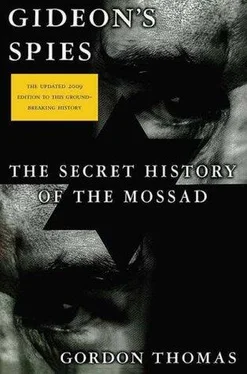Gordon Thomas - Gideon's Spies
Здесь есть возможность читать онлайн «Gordon Thomas - Gideon's Spies» весь текст электронной книги совершенно бесплатно (целиком полную версию без сокращений). В некоторых случаях можно слушать аудио, скачать через торрент в формате fb2 и присутствует краткое содержание. Город: New York, Год выпуска: 2009, ISBN: 2009, Издательство: Thomas Dunne Books, Жанр: История, на английском языке. Описание произведения, (предисловие) а так же отзывы посетителей доступны на портале библиотеки ЛибКат.
- Название:Gideon's Spies
- Автор:
- Издательство:Thomas Dunne Books
- Жанр:
- Год:2009
- Город:New York
- ISBN:978-0-312-53901-6
- Рейтинг книги:4 / 5. Голосов: 1
-
Избранное:Добавить в избранное
- Отзывы:
-
Ваша оценка:
- 80
- 1
- 2
- 3
- 4
- 5
Gideon's Spies: краткое содержание, описание и аннотация
Предлагаем к чтению аннотацию, описание, краткое содержание или предисловие (зависит от того, что написал сам автор книги «Gideon's Spies»). Если вы не нашли необходимую информацию о книге — напишите в комментариях, мы постараемся отыскать её.
Gideon’s Spies
Gideon's Spies — читать онлайн бесплатно полную книгу (весь текст) целиком
Ниже представлен текст книги, разбитый по страницам. Система сохранения места последней прочитанной страницы, позволяет с удобством читать онлайн бесплатно книгу «Gideon's Spies», без необходимости каждый раз заново искать на чём Вы остановились. Поставьте закладку, и сможете в любой момент перейти на страницу, на которой закончили чтение.
Интервал:
Закладка:
With the help of its sayanim network of Jewish volunteers throughout Britain, Mossad’s London Station gathered mounting evidence on the extent of the threat Muslim extremism posed to the United Kingdom. There were now close to five thousand sayanim in Britain in 2005, who acted as “the eyes and ears” Meir Amit had envisaged when he created the network. They were no longer made up of relatives of European Jews who had arrived in the country in the 1930s, refugees from nazism. Now they included Jews from Lebanon, Syria, and, more recently, Iraq and Iran: shopkeepers, landlords, and café owners in Asian communities who provided a steady stream of information.
An Iraqi bookseller in the north London suburb of Wembley had provided proof that Islamic extremists had reached the heart of the Blair government. Ahmad Thomson, a Muslim barrister and a senior member of the Association of Muslim Lawyers, had been appointed to advise the prime minister on how to deal with the matter. Thomson was also the author of a fast-selling book in the Muslim community. Titled The New World Order, it claimed there was “a Zionist plan to shape world events” and predicted that events like 9/11 and the suicide bombings in Israel were “part of the coming confrontation between the muminun (those who accept Islam) and the kaffirun (nonbelievers).” Other Muslim advisers to the government had, before being appointed, described Osama bin Laden as a “holy warrior” and defended suicide bombers as “genuine martyrs.”
Though the Blair government had finally promised that extremist preachers and scholars who promoted terrorism would be deported, those radical imams and teachers continued throughout the summer of 2005 to deliver their diatribes about holy war in their mosques and post inflammatory articles on their Web sites.
Mohammed al-Massari, a middle-aged Saudi militant who had fled that country to Britain and managed to convince the government he faced death if he was returned to the desert kingdom, still used his Web site in June 2005 to show videos of British and American hostages being beheaded in Iraq. He also ran an Internet radio station that called for holy war. Abu Qatada, who had fled to London from Jordan claiming he was being persecuted there for his religious beliefs, had been allowed to remain in Britain. He had repaid his host country by inciting his followers to go to Iraq and kill Coalition troops. Pakistan’s Hizb-a-Tehia, the Party of Liberation, outlawed in its own country, used its London office to recruit young Muslims to go to Afghanistan to be trained to wage war against America. In other Muslim enclaves in the north and west suburbs of London, imams preached their invective as they did in the cities of Leicester, Manchester, Leeds, Bradford, and Glasgow; thousands of young, impressionable Muslims, many born in Britain, were being indoctrinated into hatred against their own country.
All this information had been stored on his computer by Nathan. Some of it had come from his MI5 liaison officer at the Joint Terrorism Analysis Centre (JTAC) in MI5’s Millbank offices. Opened in 2003 as part of Britain’s role in the war on terrorism, JTAC’s one hundred staff were drawn from all areas of the intelligence community fighting international terrorism. They worked in a brightly lit, windowless room in the basement of the building; its unmarked door was opened only by swipe cards whose codes were changed regularly. From the workstations, equipped with state-of-the-art communications, came and went a continuous flow of information. Sensitive material, once shared only with the CIA, Mossad, and the French and German intelligence services, was now more widely distributed since the attacks on Bali and Madrid. The result had been a surge of high-value intelligence from sources like GROM, Poland’s SAS-trained antiterrorist unit. They provided details about Jamal Zougam, who was implicated in the Madrid rail station bombings and who had planned a Christmas bombing campaign in Warsaw. Spanish intelligence had sent details of Zougam’s visit to London, where he had visited the radical Finsbury Park mosque. It’s imam, Abu Hamza, had preached support for bin Laden and was now fighting extradition to the United States from his prison cell for his role in killing Americans in the Middle East. In 2006, Abu Hamza was sentenced to seven years’ imprisonment for “promoting and taking part in terrorist activities.” After he has served his sentence, he will be deported to America and will face charges of “complicity in killing U.S. citizens in the Middle East.”
A French intelligence report estimated that as a result of a recruitment drive, al-Qaeda support in the country “stands at over 3 5,000, many of them are converts to Islam. They are organized into military-style units and meet regularly for training in the use of weapons and explosives, combat tactics, and indoctrination. They are controlled from local and district command centers under the al-Qaeda national command.” In a further pooling of information, Germany’s BND reported its estimate that there were, in June 2005, around thirty thousand al-Qaeda sympathizers in the Federal Republic. Nathan had told his liaison officer that Mossad believed the movement’s leaders were based in the port city of Hamburg, from where several of the 9/11 bombers had come.
In June 2005, Nathan and his liaison officer had once more traveled to several cities in the north of England as part of an unprecedented security operation. Twenty of the world’s security services had joined forces to help protect the G8 Summit at Gleneagles in Scotland in July.
Between them they had created a security ring, which included Germany’s border with Poland, to intercept terrorists moving out of the Balkans. Spanish intelligence agents were linked through Britain’s listening posts on Gibraltar and Cyprus to monitor the North African coast, long an established launchpad for al-Qaeda into Europe. SISMI, Italy’s secret service, had deployed scores of agents to watch for terrorists coming out of the Islamic republics of the former Soviet Union. French and Dutch intelligence officers were stationed in the Channel ports.
At GCHQ, Britain’s listening post in space, linguists, analysts, and technicians continued to track intercepts, seeking the first sign of a threat. Already its computers had deciphered “chatter” that indicated the Italian anarchists planned to enter Britain ahead of the summit. American satellites, controlled by the NSA base at Menwith Hill in the north of England, watched over an area from the deserts of Iraq in the west to the Ural Mountains in the east.
The DGSE, the French intelligence service charged with protecting President Chirac at the summit, discovered that European anarchists, including the Ya Basta group, had recently met with Class War, a notorious British anarchist group, at Calais. Both groups were known to advocate violent protest. Germany’s BND secret service confirmed that German anarchists had also recently attended “a conference of anarchists” held outside Nottingham in England.
MI5, who would jointly coordinate the multinational security operation with MI6, were already hunting for an Italian terrorist nicknamed “The Raven” who was believed to have entered Britain and was known to have links to an al-Qaeda cell in Bologna, Italy, a well-known hotbed for terrorists. Details about him were discovered in a raid by Italian agents that led to the arrest of eighty anarchists who had been planning to go to Gleneagles. The CIA had assigned two hundred agents and state-of-the-art electronic equipment to protect President Bush. Russia’s three intelligence services, the GRU, the FCS, and the SVR, had provided MI5 with identikits of Chechnyan terrorists who could attempt an attack on the summit. The FCS, the Federal Counterintelligence Service, had warned JTAC (Joint Terrorism Analysis Center) that it should not discount a suicide bomber attacking during the summit.
Читать дальшеИнтервал:
Закладка:
Похожие книги на «Gideon's Spies»
Представляем Вашему вниманию похожие книги на «Gideon's Spies» списком для выбора. Мы отобрали схожую по названию и смыслу литературу в надежде предоставить читателям больше вариантов отыскать новые, интересные, ещё непрочитанные произведения.
Обсуждение, отзывы о книге «Gideon's Spies» и просто собственные мнения читателей. Оставьте ваши комментарии, напишите, что Вы думаете о произведении, его смысле или главных героях. Укажите что конкретно понравилось, а что нет, и почему Вы так считаете.












